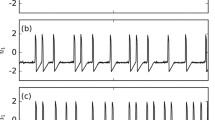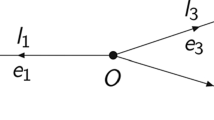Abstract
A hierarchical network of pulse-coupled spike microoscillators (MOs) capable of randomly responding to an external signal has been studied theoretically and experimentally. The network consists of Antenna units, a Central Pattern Generator (CPG), and a Decision-Making unit (DM). The external signal induces antiphase or in-phase oscillations in the microcells included in the Antenna. The CPG also has these two dynamic modes. What mode to accept for the CPG unit in response to the appearance of a dynamic mode in the Antenna is decided by the DM unit. Owing to its configuration, the DM unit makes this decision randomly. Microspheres with oscillating Belousov–Zhabotinsky reaction are used as MOs. Pulse coupling between the MOs is carried out by beams of light focused on the MOs.





Similar content being viewed by others
Notes
A BZ reaction spike is the abrupt transition of a system from a state with a predominantly reduced catalyst to a state with a predominantly oxidized catalyst and vice versa—from an oxidized to a reduced state. This fast transition is provided by autocatalysis.
REFERENCES
Klinshov, V.V., Collective dynamics of networks of active units with pulse coupling: a survey, Izv. Vyssh. Uchebn. Zaved. Prikl. Nelineinaya Din., 2020, vol. 28, no. 5, pp. 465–490.
Buzsaki, G. and Freeman, W., Editorial overview: Brain rhythms and dynamic coordination, Curr. Opin. Neurobiol., 2015, vol. 31, pp. V–IX.
Neves, F.S. and Timme, M., Reconfigurable computation in spiking neural networks, IEEE Access, 2020, vol. 8, pp. 179648–179655.
Ryu, H. and Campbell, S.A., Stability, bifurcation and phase-locking of time-delayed excitatory-inhibitory neural networks, Math. Biosci. Eng., 2020, vol. 17, pp. 7931–7957.
Liang, X., Zhang, X.C., **a, J., Ezawa, M., Zhao, Y.L., Zhao, G.P., and Zhou, Y., A spiking neuron constructed by the skyrmion-based spin torque nano-oscillator, Appl. Phys. Lett., 2020, vol. 116, p. 122402.
Spaeth, A., Tebyani, M., Haussler, D., and Teodorescu, M., Spiking neural state machine for gait frequency entrainment in a flexible modular robot, Plos One, 2020, vol. 15, p. e0240267.
Kadhim, K.L., Hermundstad, A.M., and Brown, K.S., Structured patterns of activity in pulse-coupled oscillator networks with varied connectivity, Plos One, 2021, vol. 16, p. e0256034.
Bazhanova, M.V., Krylova, N.P., Kazantsev, V.B., Khramov, A.E., and Lobov, S.A., Synchronization in a network of spiking neural oscillators with plastic connectivity, Radiophys. Quantum Electron., 2020, vol. 63, pp. 298–309.
Afifurrahman, Ullner, E., and Politi, A., Collective dynamics in the presence of finite-width pulses, Chaos, 2021, vol. 31, p. 043135.
Galinsky, V.L. and Frank, L.R., Collective synchronous spiking in a brain network of coupled nonlinear oscillators, Phys. Rev. Lett., 2021, vol. 126, p. 158102.
Gast, R., Knosche, T.R., and Schmidt, H., Mean-field approximations of networks of spiking neurons with short-term synaptic plasticity, Phys. Rev. E, 2021, vol. 104, p. 044310.
Kuramoto, Y., Phase- and center-manifold reductions for large populations of coupled oscillators with application to non-locally coupled systems, Int. J. Bifurcation Chaos, 1997, vol. 7, pp. 789–805.
Velichko, A., Putrolaynen, V., and Belyaev, M., Higher-order and long-range synchronization effects for classification and computing in oscillator-based spiking neural networks, Neural Comput. & Appl., 2021, vol. 33, pp. 3113–3131.
Taylor, A.F., Tinsley, M.R., Wang, F., Huang, Z.Y., and Showalter, K., Dynamical quorum sensing and synchronization in large populations of chemical oscillators, Science, 2009, vol. 323, pp. 614–617.
Belousov, B.P., Sbornik referatov po radiatsionnoi meditsine za 1958 g. (Collection of Short Papers on Radiation Medicine for 1958), Moscow: Medgiz, 1959, pp. 145–152.
Zhabotinsky, A.M., Periodic liquid phase reactions, Dokl. Akad. Nauk SSSR, 1964, vol. 157, no. 2, pp. 392–395.
Proskurkin, I.S., Smelov, P.S., and Vanag, V.K., Experimental verification of an opto-chemical “neurocomputer”, Phys. Chem. Chem. Phys., 2020, vol. 22, pp. 19359–19367.
Vanag, V.K., Smelov, P.S., and Klinshov, V.V., Dynamical regimes of four almost identical chemical oscillators coupled via pulse inhibitory coupling with time delay, Phys. Chem. Chem. Phys., 2016, vol. 18, pp. 5509–5520.
Feudel, U., Pisarchik, A.N., and Showalter, K., Multistability and tip**. From mathematics and physics to climate and brain-minireview and preface to the focus issue, Chaos, 2018, vol. 28, p. 033501.
Smelov, P.S., Proskurkin, I.S., and Vanag, V.K., Controllable switching between stable modes in a small network of pulse-coupled chemical oscillators, Phys. Chem. Chem. Phys., 2019, vol. 21, pp. 3033–3043.
Kuznetsov, O.P., Bounded rationality and decision-making, Iskusstv. Intell. Prinyatie reshenii, 2019, no. 1, pp. 3–15.
Mysore, S.P. and Kothari, N.B., Mechanisms of competitive selection: a canonical neural circuit framework, Elife, 2020, vol. 9, p. e51473.
Taylor, A.F., Tinsley, M.R., and Showalter, K., Insights into collective cell behaviour from populations of coupled chemical oscillators, Phys. Chem. Chem. Phys., 2015, vol. 17, pp. 20047–20055.
Mallphanov, I.L. and Vanag, V.K., Distance dependent types of coupling of chemical micro-oscillators immersed in a water-in-oil microemulsion, Phys. Chem. Chem. Phys., 2021, vol. 23, pp. 9130–9138.
De, T.K. and Maitra, A., Solution behaviour of Aerosol OT in non-polar solvents, Adv. Colloid Interface Sci., 1995, vol. 59, pp. 95–193.
Proskurkin, I.S. and Vanag, V.K., New type of excitatory pulse coupling of chemical oscillators via inhibitor, Phys. Chem. Chem. Phys., 2015, vol. 17, pp. 17906–17913.
Stankevich, N. and Volkov, E., Evolution of quasiperiodicity in quorum-sensing coupled identical repressilators, Chaos, 2020, vol. 30, p. 043122.
Canavier, C.C. and Achuthan, S., Pulse coupled oscillators and the phase resetting curve, Math. Biosci., 2010, vol. 226, pp. 77–96.
Safonov, D.A. and Vanag, V.K., Oscillatory microcells connected on a ring by chemical waves, Chaos, 2021, vol. 31, p. 063134.
ACKNOWLEDGMENTS
We thank I.L. Mallphanov for the preparation of BZ microspheres and microemulsions.
Funding
This study was supported by the program of strategic academic leadership “Priority 2030” of Immanuel Kant Baltic Federal University.
Author information
Authors and Affiliations
Corresponding authors
Additional information
Translated by V. Potapchouck
Rights and permissions
About this article
Cite this article
Proskurkin, I.S., Vanag, V.K. Random Decision-Making in Networks of Pulse-Coupled Spike Oscillators. Autom Remote Control 83, 935–945 (2022). https://doi.org/10.1134/S0005117922060108
Received:
Revised:
Accepted:
Published:
Issue Date:
DOI: https://doi.org/10.1134/S0005117922060108




